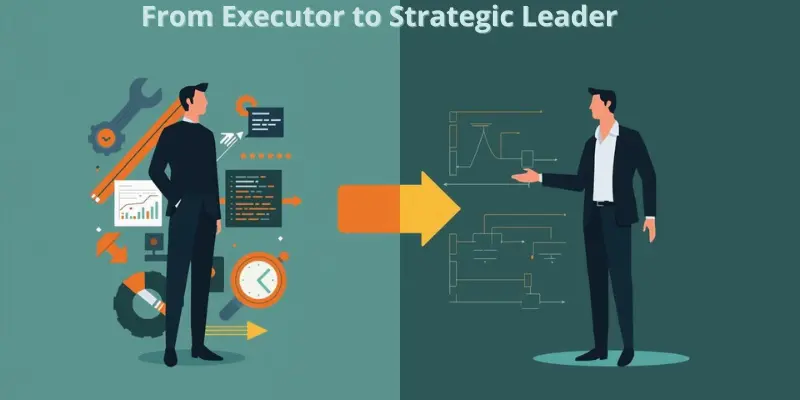The 7 Core Skills of Business Acumen: Why They’re Crucial for Your Career
Published: 03/09/2025
You’ve probably heard the term “business acumen” thrown around—especially when talking about rising stars or future leaders—but rarely do people pause to explain what it actually means. That’s a real problem. When a phrase is widely used but barely defined, it leaves professionals—especially learners and those aiming for leadership—wondering how to develop it or what it even looks like.
I’ve been there. It can feel like chasing a moving target. So let’s cut through the noise.
This post is your no-nonsense guide to understanding and building business acumen—the real deal. Here’s what you’ll get:
- A clear, definition of what business acumen truly is and why it matters (not marketing fluff).
- Real-life examples that show what this skill looks like in action—so it stops feeling abstract.
- A practical roadmap for how you can develop it in your own work, today—not someday.
By the time you finish reading, you’ll have a grounded grasp of what business acumen is, why it matters, and exactly how to start building it. Let’s get going.
Debunking the Myths: What Business Acumen Is and Isn’t
Let’s start by clearing the air. Two ideas tend to trip people up—and putting them to rest early helps you trust what follows.
Acumen Is a Skill, Not a Talent
You might be thinking, “Some people are just born with it.” But the truth is different—and it’s good news.
Business acumen is something you can build. It’s not a mysterious gift reserved for a few. Multiple sources show this skill is learned, through experience and reflection.
According to research, business acumen grows when professionals gain exposure to different roles and deliberately absorb lessons from mentors, real-world challenges, and structured training—not just natural ability.
“Business acumen is a learned skill of increasing importance within the corporate world.”
That means your approach—curious, open to trying new things, looking beyond your daily tasks—is exactly how you build it.
More Than Just Numbers
A second misconception: thinking business acumen is all about financial literacy. You’re right to learn to read a balance sheet—but that’s only part of the story.
True business acumen blends:
- Financial literacy – understanding income statements, cash flow, and profit margins
(Culture Partners) - Strategic insight – seeing how your work or decisions connect to larger business goals
(Culture Partners) - Operational awareness – recognizing which business functions drive value and which cause bottlenecks
(Culture Partners)
Here’s a way to think about it: Financial skill is the vocabulary. Strategic and operational awareness grant you fluency.
In practice, someone with strong business acumen doesn’t just read a profit and loss sheet—they ask: “How will this affect customer trust? Can we change one process to reduce cost without hurting experience?”
Why This Matters for You
- You’re not stuck if you don’t “have it.” Acumen is built.
- Focusing only on numbers won’t get you where you want to go—you need to connect them to purpose, customer value, and the bigger picture.
Let’s keep going—next up: the 7 core skills that make up business acumen, and how you can start practicing them today.
The 7 Core Skills That Define Business Acumen
Let’s break down what business acumen actually looks like—skill by skill. Think of each as a piece of the puzzle that, when combined, gives you a clear, practical view of business fluency.
Financial Acumen: The Language of Business
Understanding the basics of financial statements keeps you anchored in reality—profit and performance.
- Learn to read an income statement—it tells you how revenue turns into net profit over a time period.
(Bench, Wikipedia) - Review a balance sheet—a snapshot showing what a company owns vs. owes at a moment in time (Assets = Liabilities + Equity).
(Schwab Brokerage) - Putting them together reveals trends like cash flow, profitability, and how healthy the business actually is.
(Culture Partners)

Actionable Tip: Grab a real or sample P&L and balance sheet. Ask: Where is profit coming from? Where’s the risk (debt levels, cash burn)? What’s changed quarter-over-quarter?
Strategic Acumen: Seeing the Big Picture
Strategic acumen is your lens on the future—it’s about accuracy under uncertainty.
- It’s the ability to analyze your industry, map out competitors, and plot smart moves ahead.
(Business Think) - It includes predictive thinking—spotting shifts in demand, tech, or regulations before they crash into your plans.
(Business Think) - Strategic awareness leads you to set directions that give your company a sustainable competitive advantage—whether through brand, price, or innovation.
(Investopedia, Wikipedia)
Actionable Tip: Run a quick SWOT or competitor analysis in your field. What gives your company—or your role—a real edge? Where might that edge erode?
Leadership & People Acumen
This is how you make business moves happen—through others.
- SHRM includes Business Acumen alongside behavioral competencies like Leadership, Consultation, and Relationship Management.
(SHRM) - Business acumen shows up when teams align with organizational goals—and commanders win trust by showing how each action matters.
(HR Aligned Design, AIHR)

Actionable Tip: Next team meeting, ask yourself: How does this task tie into revenue, customer outcomes, or growth? Then, share that link with the team to boost clarity and trust.
Analytical & Data Acumen
Raw data is noise—insight comes from how you shape it.
- Strong data acumen means turning numbers into stories—trends, signals, risk flags, or growth paths.
- You might map steps like collection, cleaning, trend spotting, then building a narrative or recommendation.
Actionable Tip: Pick one metric in your role (e.g. time to complete a task). Track it this week. Is the cycle time improving, staying flat, or slipping? What’s behind that shift?
Operational Acumen: Understanding the Engine
Operations are where strategy meets reality—this is where businesses live or stumble.
- Operational acumen means understanding workflows, process bottlenecks, and resource gaps.
- You notice when action slows—like delays in customer onboarding or missteps in delivery.
Actionable Tip: Map out one process—maybe customer support or order fulfillment. Note places where delays or extra cost live. Then ask: “What small shift could save time or money?”

Commercial Acumen: The Sales & Revenue Driver
This one ties business to the market—what makes customers buy and stay.
- It’s using customer insights and market knowledge to close deals and grow value.
(Culture Partners, Alooba, acumenacademy.org, Augment, The Times of India) - You see commercial acumen when you connect customer needs, pricing dynamics, and product features.
Actionable Tip: Ask a customer-facing colleague or speak to a customer. What matters to them? What’s their pain—and how can your team help solve it?
Project & Technology Acumen
Knowing the latest tools, and how to use them correctly, gives you leverage.
- Understanding new tech and how projects flow today ensures you stay agile and relevant.
- It means knowing which workflows tech can fix—and when people skills beat automation.
Actionable Tip: Try using a lightweight project tool (like Trello or Asana) for your next task. Note what changed—it could save time, clarity, or reduce errors.
Why This Matters
Each of these seven skills supports one thing: contextual decision-making. Together, they help you see the whole picture. And that’s what separates someone who works in the business from someone who can work at the business—guiding it, growing it, and shaping it.
Why Your Career Depends on Business Acumen
As you step beyond being a crack technician, coder, or analyst, business acumen becomes the skill that separates leaders from experts. Here’s why it matters so much for your career.
Bridging the Gap from Expert to Leader
No matter how deep your technical skills run—whether you’re great at programming, engineering, or analytics—those are about doing. Leadership is different. It’s about seeing the stakes, weighing options, and steering the ship.
- A senior source explains it well: business acumen lets you view the broader organization—not just your part —and understand how your decisions ripple across teams, budgets, and strategy. It’s your ticket from executor to decision-maker.
(Culture Partners) - Leaders with acumen can speak strategy fluently. They don’t just fix problems—they guide direction. This shift, from focusing on tasks to influencing outcomes, is critical for promotion.
(Culture Partners)

Action Step: Show up with insight. When you make a recommendation, connect it to vision and value—how will it support long-term goals or competitive edge?
Earning Trust & Credibility
Senior leaders and clients trust people who understand how things fit together—not just what they’re good at.
- A recent report finds business acumen is among the top five skills companies look for in future leaders. People who own it are seen as credible, decisive, and ready for bigger roles.
(Culture Partners, insight-experience.com) - In HR and support roles, acumen transforms perception. Instead of being “just HR,” professionals become valued business partners who shape decisions. That shift builds real influence.
(Growthspace)
Action Step: At your next update or client meeting, frame your contributions in business terms. Instead of saying “I implemented X,” you might say, “I implemented X to reduce costs, increase efficiency, or protect revenue.” It might feel small—but credibility starts here.
Why This Matters for Your Path
- Promotion-friendly: Business acumen unlocks leadership roles by showing you can balance vision and detail.
- Trust across the board: When you tie your work to business outcomes, you’re not just seen—you’re heard.
- Career anchor: As roles shift, technology evolves, and teams restructure, this skill stays essential and portable.
Your Action Plan: How to Build Your Business Acumen Today
Ready to move beyond definitions? Here’s how to turn understanding into real skill—starting now.
Learn with Purpose (Formal Education)
Studying with intention makes a difference. Structured learning clarifies concepts and lays a solid foundation.
- CIPD’s Business Acumen Introductory Programme is a compact, six-hour online course that teaches how to read business models, use important metrics, support planning, and build ethical, value-driven relationships. It’s self-paced and ideal for those just starting.
(Celemi, shop.cipd.org) - CIPD Level 7 Advanced Diploma in Strategic People Management offers deeper learning. You’ll develop business acumen through modules on ethics, strategic HR, and business research. This qualification is respected and accepted in senior HR roles.
(ICS Learn)
Actionable Step: Pick a course level that fits you—short, online modules or a more comprehensive qualification—and block out a few hours to kick it off this week.
Learn by Doing (Real-World Experience)
There’s no substitute for real-world practice. Immersion reveals what theory can’t.
- Business simulations, particularly from Celemi, let you step into a safe environment to make decisions, see consequences, and sharpen judgment. Their simulations cover finance, strategy, agility, and leadership.
(Celemi) - For example, Celemi’s Apple & Oranges™ simulation walks you through how decisions affect cash flow, operations, and collaboration—making the impact of business thinking crystal clear.
(Celemi)
Actionable Step: Ask your learning team or manager if you can join a business simulation or trial one. If unavailable, create a small experiment in your team—run a mini SWOT together or simulate a customer response scenario.
Learn from Others (Mentorship)
Sometimes the fastest path to insight is a conversation.
- Shadow a colleague with strong business sense or volunteer to support their next project. Watch how they frame decisions and connect small actions to big goals.
- In team meetings, listen for phrases like “impact on budget,” “customer outcome,” or “bigger picture.” Make a note—and try using one of your own next time.

Actionable Step: Reach out to someone you admire in your company—ask if you can sit in on a planning session, or just grab their insight over a virtual coffee.
Why These Steps Matter
- Formal learning kicks off the foundation—concepts, structure, and confidence.
- Simulations and live projects give you space to practice, make mistakes, and learn from them.
- Mentorship brings perspective and context, helping you see how business acumen plays out in real situations.
Each builds habit. Each adds clarity. Start small, keep growing.
Expert Tips for Mastering Acumen
These three practical habits can go a long way in turning business acumen from theory into daily habit. Let’s break them down.
Tip 1: Connect the Dots
Make it a habit to ask: “How does this affect revenue?” or “How does this impact the customer?” — especially when you’re working through daily tasks.
Why it matters: Leaders who can articulate their ideas in terms of strategy, market, and financial impact stand out—and often get heard. That clarity puts your ideas in the company’s bigger picture.
(Professional Leadership Institute, Harvard Business Impact)
Quick Try This: Start each update or decision with a simple line: “Here’s what I plan to do… and here’s why it matters to the bottom line or customer.” It may feel small—from technical to strategic, you’re building bridges.
Tip 2: Read What the Leaders Read
Make space in your schedule for smart reading:
- Industry reports
- Competitor annual reports
- Publications like The Wall Street Journal or Harvard Business Review
This isn’t about feeling behind—it’s about understanding what matters right now and where things are heading.
Why it matters: When you stay informed, you can speak with context, connect your work to industry dynamics, and anticipate what’s ahead. That’s how you rise beyond execution into leadership.
(Culture Partners)
Tip 3: Think Like a CEO
Occasionally, step back and ask yourself: If this were up to me, what would I do?
CEOs think in terms of long-term value, company-wide impact, and trade-offs—not just today’s tasks.
Looking through that lens trains your mind to balance daily details with strategic awareness. You don’t need to solve the next board-level issue—but practicing that frame of thinking sets you up for bigger opportunities.
(GaneshBabu)
Why These Matter
- Connecting the dots sharpens how you see impact and signals strategic awareness.
- Reading leaders’ sources keeps your insight relevant and timely.
- Thinking like a CEO helps mold your instinct for what truly matters beyond execution.
Action Step: Pick one of these to try this week. Maybe it’s summarizing what you’re doing—and why it matters—or reading one HBR article with your morning coffee.
Financial Acumen: The Language of Business (Revised with Case Study)
Understanding financial statements isn’t just about numbers—it’s about seeing the story behind them.
- Income statement: Shows how revenue transforms into net profit over a specific period.
- Balance sheet: Offers a snapshot of what a business owns (assets) versus what it owes (liabilities and equity).
- Together, they reveal strengths, risks, and areas for improvement.
Quick Action Tip
Use a real or sample financial report. Ask:
- Where is profit coming from?
- What costs are eating into it?
- Which line item needs your attention first?
Case Study
BrightBrew Café improved its net profit by 8% .
The Story in Steps:
- Problem
BrightBrew noticed its revenue kept rising—but profit wasn’t following. Ingredient and staffing costs were growing faster than sales. - Insight
A glance at the income statement clarified the issue: the low-margin pastry line was dampening returns. - Action Taken
BrightBrew stopped offering that pastry and renegotiated supplier prices for ingredients. - Outcome
Net profit turned around—improving by 8%. The move showed how informed decisions based on financial clarity can move the needle quickly.
Leadership & People Acumen: Guiding with Business Insight
Make this shift: instead of diving into technical details, frame team decisions around impact. Ask yourself—or better yet, share—something like: “How does this align with revenue, customer value, or growth?” That shift builds trust and helps your team move with purpose.
Real-Life Leadership Moment
Framing matters more than you might think—how a leader presents an idea can change everything. In fact, leadership experts note that “how leaders frame situations disproportionately impacts how teams do their work”—and when the frame is clear, alignment and unity follow.
The Story in Four Steps
- Problem
A leader on your team was preparing the rollout of a new product—but the discussion stuck to specs and features. Team members were working in silos, disconnected from the bigger picture. - Insight
You noticed the meeting lacked a “why.” So you asked: “How will this change benefit our customers? What outcome are we aiming for?” That question shifted the tone immediately. - Action Taken
The team reframed updates to connect features with customer impact—for instance: “This new feature will reduce user setup time from 24 hours to 4—making onboarding smoother and saving support costs.” - Outcome
The energy changed. Everyone understood how their work mattered. Discussions became strategic, ideas connected, and trust grew. The team started aligning on goals, not just tasks.
Quick Guide
| Element | How to Apply It in Your Team |
|---|---|
| Problem | Identify when conversations—or projects—feel dry or disjointed |
| Insight | Ask a strategic “why does this matter to business or customers?” |
| Action | Shift framing: connect features/tasks to outcomes |
| Outcome | Notice how focus, trust, and alignment improve |
Learn with Purpose (Formal Education)
Structured learning lays a strong foundation—you get concepts, context, and confidence to act.
- CIPD’s Business Acumen Introductory Programme offers quick, well-paced learning on financial literacy, business planning, and real-world application.
- For a deeper dive, the CIPD Level 7 Advanced Diploma in Strategic People Management develops strategic thinking and business analysis alongside HR leadership.
Why This Matters in Real Terms:
A Forrester Total Economic Impact (TEI) study found that organizations using Coursera for Business saw a 327% return on investment over three years, driven by increased productivity, time saved on course development, and reduced certification costs (blog.coursera.org).
Conclusion: Your Next Steps to Career Success
You’ve walked through how business acumen isn’t a secret talent—it’s something you can build. You’ve seen its core building blocks:
- A skill set that people learn, not inherit.
- Seven practical competencies that come to life in daily decisions.
- Why this skill can be the turning point between being a technical expert and becoming a strategic leader.
And you’ve got tools within reach:
- Purposeful learning, whether through targeted courses or a more structured diploma.
- Real-world practice via simulations, projects, and cross-functional work.
- Mentorship and observation—two of the fastest ways to internalize this thinking.
You already have everything you need to begin this journey.
Start with one skill today and apply a new way of thinking in your next team meeting to begin your journey to becoming a leader.
Still Have Questions? We Have Answers
Business acumen means understanding how a business works—like its finances, how it grows, and how decisions affect the customer and the bottom line.
It includes planning, operations, finance, and strategy.
Yes. People build it over time through training, real tasks, and practice. Even if you’re not a leader yet, you can grow it.
You notice patterns, make smart decisions, think ahead, and talk about business rather than just tasks.
Absolutely. It’s more about seeing how things connect than using tech. Anyone can learn it.
Numbers are useful, but acumen is about seeing how those numbers affect business health, customers, and choices.
Definitely. Questions like “How does this help the customer?” help people understand impact and feel connected.
Ask yourself: Do I grasp how our business works? Can I spot opportunities or risks? Can I explain why decisions matter?
It helps you move from doing tasks to making decisions, gaining trust and transitioning into leadership.
Seeing the Big Picture* by Kevin Cope is a clear, easy read that shows how business works.
Share a story where your choices helped the team or customer. Use a simple format: what you did and why it mattered.
Absolutely. Even in individual contributor roles, reframing your work in terms of impact helps cultivate the mindset.
It varies, but habits like analyzing decisions through a business lens show early results—real fluency often develops over months of practice.
Business acumen isn’t just about numbers. It blends “technical knowledge” with “curiosity”, “adaptability”, and a willingness to learn across teams and functions.
Yes. When employees learn the language of business—profit, cash flow, strategy—they shift from doing tasks to making meaningful contributions.
You can align daily work with how the business competes—and deliver real value. Seeing the “big picture” helps your decisions matter more.
Simulations give you a safe way to “practice decisions under pressure” and see results. They make learning stick by letting you experience cause and effect in a business setting.
Yes. Business acumen is widely recognized as a “core competency”, both for individuals and organizations. In HR, for instance, it’s one of the essential core skills—alongside data literacy and people advocacy—needed to align daily activities with strategic business goals. At the organizational level, business acumen is a vital capability that enables intelligent decision-making, strategic adaptability, and cross-functional alignment with a company’s mission and financial health.
Business acumen in the workplace means understanding how the business operates—how decisions get made and how work links back to strategy. It’s about knowing the big picture: how finance, operations, and the market work together—then acting so your work supports the company’s goals.
Business acumen in project management means understanding the bigger business context—so project decisions align with organizational goals.A project manager with business acumen doesn’t just ask, “How do we deliver this project?” They also ask, “Why are we doing it? How does it support the business?” This skill helps ensure projects drive real value rather than just ticking boxes. Real-world examples show that understanding organizational strategy, finances, and market conditions helps project managers make smarter, more impactful choices.

- Be Respectful
- Stay Relevant
- Stay Positive
- True Feedback
- Encourage Discussion
- Avoid Spamming
- No Fake News
- Don't Copy-Paste
- No Personal Attacks



- Be Respectful
- Stay Relevant
- Stay Positive
- True Feedback
- Encourage Discussion
- Avoid Spamming
- No Fake News
- Don't Copy-Paste
- No Personal Attacks





